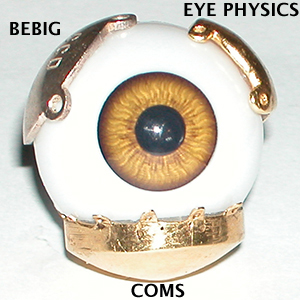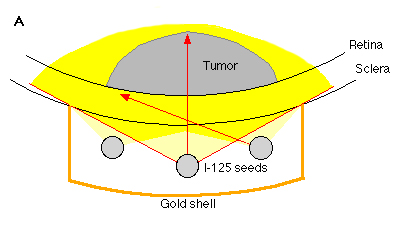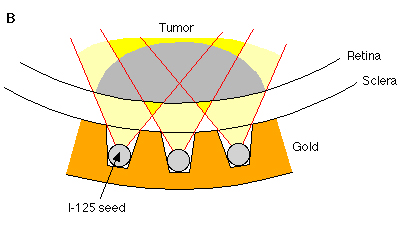The picture on the right compares the relative thickness of the 106Ru applictors made by BEBIG, the 125I (or 103Pd) plaques used by the COMS, and the Eye Physics plaques.

|
The picture on the right compares the relative thickness of the 106Ru applictors made by BEBIG, the 125I (or 103Pd) plaques used by the COMS, and the Eye Physics plaques. |

|
|
The plaques designed for the COMS displace the 125I seeds by 1 mm from the sclera. Increasing the distance of a radiation source from the treatment volume reduces the geometrical inverse square effect resulting in a more homogeneous dose distribution. By offseting the seeds, the ratio of dose to regions proximal to the tumor apex (such as the sclera underlying the tumor) compared to dose at the tumor apex is less than it would be if the seeds were closer to the eye. It also means that the relative dose to regions of the eye distal to the apex is slightly increased. The COMS approach also results in a rather thick plaque. Using distance to reduce the effects of inverse square is a good approach for a single seed. |

|
|
Eye Physics plaques are thinner than the equivalent diameter COMS plaques and move the seeds physically closer to the eye. Because the distance between the seeds and tumor apex is less than in the COMS design, the inverse square effect is greater, so dose to the distal eye is slightly reduced compared to the COMS plaque! Dose to the proximal portion of the eye is also generally less than the COMS design. How can this be? All 3rd generation Eye Physics plaques and most of the 2nd generation plaques employ a slotted design which positions collimating edges of gold in close proximity to the linear axis of each seed. These collimating edges absorb much of the shallow angle, laterally directed primary radiation emitted from each seed. This is radiation that does not directly encounter the tumor and which would otherwise overlap in the sclera and retina in front of a seed with laterally directed radiation from adjacent seeds. Depending upon a seed's orientation with respect to the rim of a plaque, slot collimation can also produce a fairly steep dose gradient beyond the plaque rim. The collimated fields of view of the slots are designed to overlap in the sclera below the base of the tumor to prevent cold spots. Close to the source axis itself, internal self absorption (anisotropy) at shallow angles also serves to reduce the scleral and retinal dose. This approach would not work for a single seed, but works well when there are many seeds. An analogy is external beam treatment using IMRT, CyberKnife or GammaKnife radiosurgery. None of these modalities would be effective given only a single beam. They depend on a large number of highly collimated beams coming from many directions, all converging on the tumor. |

The above pictures illustrate the general principles of slotted vs shell & carrier collimation in a plane perpendicular to the seed axes at their centers, the illustrations do not specifically apply to any particular plaque model. |